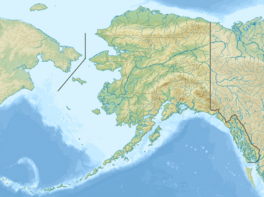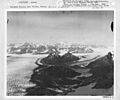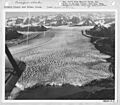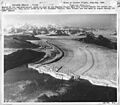Columbia Glacier (Alaska) facts for kids
Quick facts for kids Columbia Glacier |
|
|---|---|
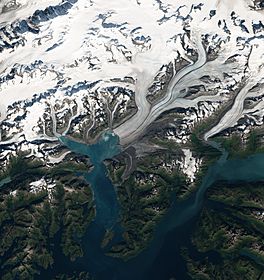
Satellite image, September 2018
|
|
| Type | Tidewater glacier |
| Coordinates | 61°13′11″N 146°53′43″W / 61.21972°N 146.89528°W |
| Area | 1,000 km2 (400 sq mi) |
| Length | 51 kilometers (32 mi) |
| Thickness | 550 m (1,800 ft) |
| Terminus | Sealevel (Prince William Sound) |
| Status | Retreating |
The Columbia Glacier is a huge river of ice. It is located in Prince William Sound in Alaska, USA. This glacier is one of the fastest moving glaciers in the world. It has been shrinking since the early 1980s.
The glacier was named after Columbia University. This happened in 1899 during the Harriman Alaska Expedition. Many glaciers in this area were named after famous U.S. colleges. The main part of the glacier starts between Mount Witherspoon and Mount Einstein.
The Alaska Marine Highway System has a ship named after this glacier. It is called the M/V Columbia.
How Big is Columbia Glacier?
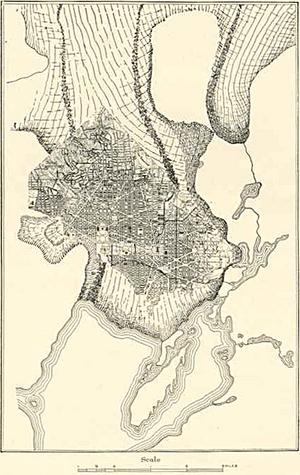
The Columbia Glacier winds its way through the Chugach Mountains in western Alaska. Imagine a giant ice river flowing through mountains!
There is a clear line on the mountains near the glacier. This line is called a "trimline." It shows how much the glacier has shrunk. The Columbia Glacier has lost about 1,300 feet (400 m) of its thickness. That's like losing the height of a very tall building!
Since 1910, the glacier has also pulled back a lot. It has retreated about 10.5 miles (16.9 km). This means its end point is much farther back than it used to be.
Why is the Glacier Shrinking?
Glaciers like Columbia Glacier are always moving. When a glacier "retreats," it means its front edge is melting faster than new snow and ice can build up. So, the glacier gets shorter.
How Fast is it Retreating?
In 2001, the Columbia Glacier was retreating very quickly. Its front edge was moving back almost 30 meters (98 ft) every day. It was also breaking off huge pieces of ice. These pieces are called icebergs.
Since 1982, the glacier has retreated a total of 16 km (9.9 mi). This is an average of about 0.6 km (0.37 mi) each year. As it retreats, the glacier also gets thinner. It has lost almost 500 m (1,600 ft) of its thickness at its current end.
Scientists expect the glacier to retreat another 15 km (9.3 mi). This will happen in the next few decades. It will reach a point where its bottom is above sea level. This means it will no longer be a "tidewater glacier" that touches the ocean.
What Causes Glacier Retreat?
The retreat of a tidewater glacier is complex. It's not always just about the climate getting warmer. Sometimes, nearby glaciers can be growing while others are shrinking.
However, a long period of warming can make a glacier thinner. This thinning can then trigger a rapid retreat. The Columbia Glacier's retreat is expected to finish around 2020.
Images for kids
Glacier photographed in 1934


